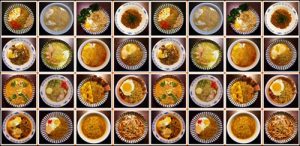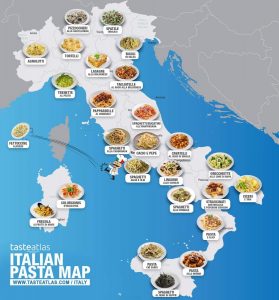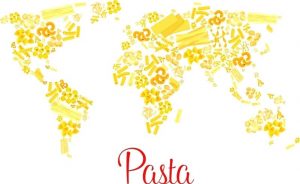In a recent survey, I asked five of my American friends where they believe the noodle originated. They all replied with China. When I asked one of the participants why they didn’t consider it to be from Italy, he replied with, “Well you asked me where the noodle originated, not pasta!” In a different survey, I asked five different Americans where they believed pasta originated. Four of them said Italy, and one of them said China. This short survey only reinforced what I believe are the common misconceptions of the word “noodle” and “pasta”, which is that the “noodle” refers to a food of the Chinese cuisine, where as “pasta” refers to a food of the Italian cuisine, and “pasta” is different than “noodles”. In this post, I hope to clear up some of the common misconceptions about the noodle through its origin and significance.
In China, the origin of noodles dates as far back as the Han dynasty, where they were commonly referred to as “cake(饼)”, according to the “Noodles, traditionally and today” article (Zhang 2016). While there were several different shapes of noodle, the vast changes in shapes and its increase in production is credited to the Wei, Jin, Northern and Southern Dynasties. The change in the shape of the noodles brought about the development of two special kinds of noodles called “shui yin (水引)” and “bo tuo(馎饦)” (Zhang 2016). Shui yin is prepared by “pulling the dough into strips as think as chopsticks”, soaking them in water after cutting them into long pieces, then flattening them into “noodles shaped as a leek leaf” and cooking them in a pot of boiling water (Zhang 2016). As the variety of noodle shapes increased, especially during the Sui, Tang, and Five dynasty periods, so did the different techniques of preparing and cooking these shapes. These various methods and techniques of cooking gave rise to several exotic types of noodles such as pig and sheep raw noodles. One of the unique noodles, with a strong gripping characteristic shape, was even referred to as “one of the seven wonderful health foods”, and it was said that the “wet noodles can be used to tie the shoe” (Zhang 2016). One of the most famous types of noodles was brought about in the Qing Dynasty, and these were referred to as the five spicy noodles and eight treasures noodles. These variations of the noodle gave rise to the various unique noodles that we enjoy and eat today.

As the various noodles traveled and developed, different regions in China began crafting and cooking the noodles differently. This goes to say that some of the differences in noodles we see today can be classified by the region they originated from. Moreover, each region specializes in the cooking of a specific noodle: East China features Shanghai Noodle in Superior Soup, while Southern China is famous for Guangzhou Wonton Noodles, and Central China features Wuhan hot noodles with sesame paste. There are several ways in which these various noodles represent the culture of the region where they originate, but most importantly, its diversity is an ode to each regions’ specific environment and access to different resources, which illustrates how they are so indicative of different regions, cultures, and people who cook them.
Not only are the noodles representative of the various diverse regions, but they also illustrate the diverse cultural and traditional values of Chinese society. There is a fascinating story behind why Quishan minced noodles were originally called “sister-in-law noodles” and later called “ashamed-son noodles”, which serves to explain the societal values of these noodles. The story goes that there was an orphan scholar who was raised by his brother and sister-in-law. The sister-in-law was a really good cook, and would make him these special noodles that would “let him read books for fame” (Zhang 2016). He passed the examinations, and as a result, the noodles were named the “sister-in-law noodles”. In an effort to replicate the same success, the parents began cooking these noodles for their children to achieve similar success, however the children failed, and as a result, these noodles were named, “ashamed son noodles”. With an abundance of stories and unique names for the noodle like so, it is hard not to see how reflective the noodle is of the Chinese culture, values, and traditions of the people that cook them.
This reflection of noodles on region, culture, and people is not just unique to China. The Italian noodle, or pasta, has become such a universal household necessity, that it is difficult to find someone who is not aware of at least one kind of Italian pasta. Pasta is such an integral part of the food history of Italy, and is often misconstrued, especially in school. According to the article “History of Pasta”, many school children were taught that Marco Polo was responsible for bringing pasta to Italy from his adventures in China, however this is far from the truth. Pasta already played an integral role in the food history of Italy, long before Marco Polo came to be. Pasta can be dated back to the Etrusco-Roman era where dry pasta was a staple. Even though Italy is a far smaller country than China, the pasta in Italy still has vast regional differences, with the biggest difference in pasta between the North and South of Italy. In the Middle Ages, Arabic invasions in the 8th century resulted in a heavy Mediterranean influence on the pasta of Italy. This Mediterranean influence is uniquely noticeable in the Italian region of Sicily, in which pasta dishes are made with unique ingredients such as cinnamon and raisins. In comparison, from my experiences, the pasta in the North has a very different style. The pasta cooked in Northern Italy is a result of a lot of French and German influences, which highlights the various resources specific to that area. The Italian peninsula is so rich in history, and the different kinds of pasta sprinkled from the North to the South of Italy have shaped what we know as pasta today. I believe that this historical implication is the primary reason why pasta is such an integral part of Italian culture and society. While we can trace the origins of pasta all the way to the Etrusco-Roman era, the main reason why pasta has become such a global commodity is due to the Age of Exploration. According to the same article, pasta, especially dry pasta, was the perfect dish for voyagers on long journeys as it was high in nutritious value and was able to stay good for long periods of time. It was due to these factors that pasta was able to cross borders, make its way around the world, and impact the lives and cultures of every society it met.

Nowadays, there are over 300 various shapes and varieties of dried pasta in Italy, and many of these shapes range from, “simple tubes to bow ties, to unique shapes like tennis rackets.” As mentioned in the “Encyclopedia of Pasta Introduction”, many shapes of pasta have been given “endearing” names such as “farfalline (little butterflies)” and “margherite (daisies)” (Zanini De Vita 1936). This shows that many of pasta names that we know of today are related to beautiful shapes in nature. These unique shapes of pasta are a testament to its rich history in Italy, and are indicative of the culture, traditions, and people cooking them. One important cultural value of the Italians with regards to pasta is that it must always always always be prepared by hand, just as how the nonnas in “How to Create Pasta like a Badass Italian Nonna” did, which is a form of art in itself. This idea of pasta as a form of art reveals a key value of the Italian culture—discipline. The Italians never sway from this traditional preparation of the noodle.

In my country of origin, India, noodles are represented in various ways across different regions, just like as seen in both China and Italy. One of the most popular, and delicious versions of the noodle is present in a dish called falooda, as pictured above. The noodles used in making falooda are vermicelli rice noodles, which is traditionally a very thin type of pasta. In Italy, vermicelli is slightly thicker than spaghetti, but in Asian countries, vermicelli is similar to that of angel hair pasta or capellini. In India, the vermicelli used in falooda is very thin, and is made traditionally from wheat, arrowroot, cornstarch, and sago. What makes falooda especially unique is that unlike other noodle and pasta dishes, falooda is a dessert. The vermicelli noodles are usually mixed with rose syrup, sweet basil seeds, ice cream and milk. While falooda is a very popular dessert in India, contrary to popular belief, this dish actually originated in Iran, and was brought over to India by Muslim merchants and dynasties that settled in India. Nowadays falooda is popular in Bangladeshi and Pakistani culture and is usually served on Islamic holidays and various other occasions. There are also many variations of falooda across the Indian subcontinent. Some parts of India make their falooda with fruit jelly instead of nuts, while others use strong black tea and tapioca pearls. Similar to noodles in China and pasta in Italy, falooda varies from region to region across India, representing the various cultures and traditions unique to each region.
In my opinion, noodles are one of the most versatile dishes in the world. As a food item, noodles not only serve to fill out big appetites, but they also provide a cultural, societal, and economical value. They have influenced and connected every part of the world, while also maintaining a sense of self and uniqueness to communities and regions. This complicated, yet simple, food item has served to unite the world, and transcend boundaries. While there are various definitions of the noodle and pasta today, I believe many are not as open-minded and inclusive of all regions and cultures cooking them. If I were to define the noodle, I would say that it is a diverse food made from a dough that can be shaped and cooked in any way, which has allowed it to cross borders and continues to do so to this day, while also shaping cultures as it travels. Below is a picture I believe encompasses my definition of the noodle.

Works Cited:
Vita, Oretta Zanini De, et al. Encyclopedia of Pasta. University of California Press, 2009.
“History of Pasta.” Life in Italy, 5 Nov. 2018, www.lifeinitaly.com/food/history-of-pasta <%22http://>.
The Truth About Pasta. The International Pasta Organization, 2016, oldwayspt.org/system/files/atoms/files/TruthAboutPasta16.pdf.
Zhang, Na, and Guansheng Ma. “Noodles, Traditionally and Today.” Journal of Ethnic Foods, vol. 3, no. 3, 2016, pp. 209–212., doi:10.1016/j.jef.2016.08.003.
fruite-falooda-ice-cream-recipe.jpg
https://solemiobg.com/en/pasta-around-the-world
https://www.google.com/url?sa=i&rct=j&q=&esrc=s&source=images&cd=&ved=2ahUKEwjX_NLR4NbjAhVDC6wKHTgQDboQjRx6BAgBEAU&url=https%3A%2F%2Fwww.seriouseats.com%2F2012%2F03%2Framen-rater-top-10-noodles-around-the-world.html&psig=AOvVaw1YGBoaam20JoJYPmMiyj7a&ust=1564373528804291
